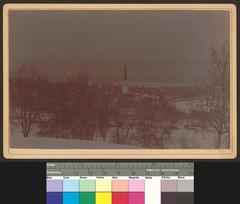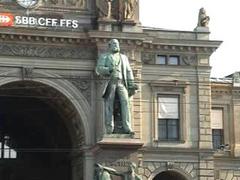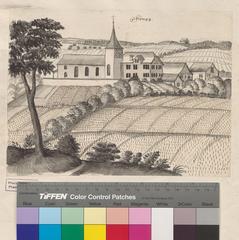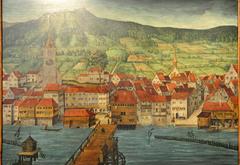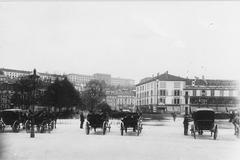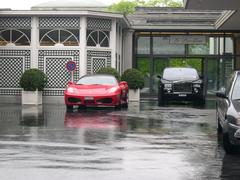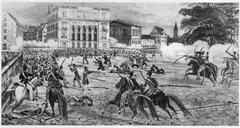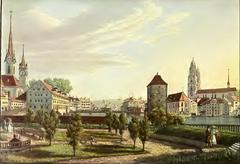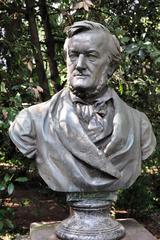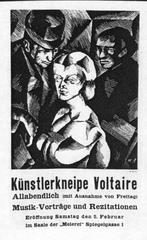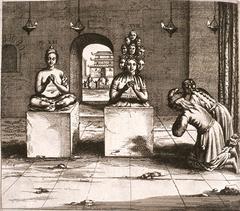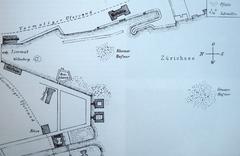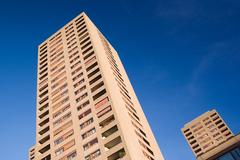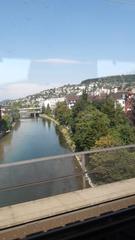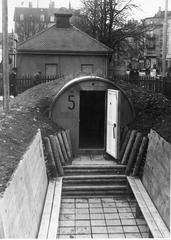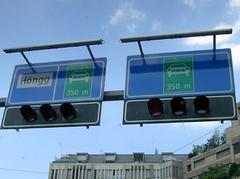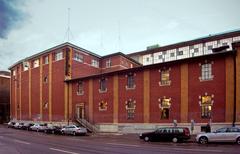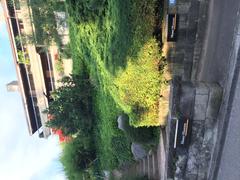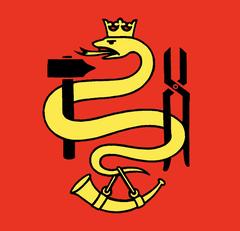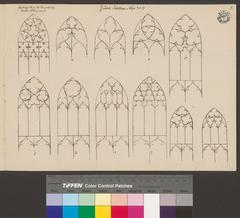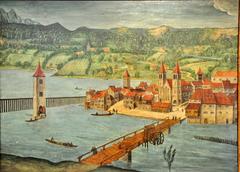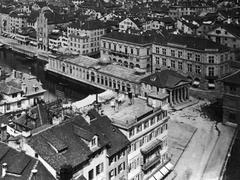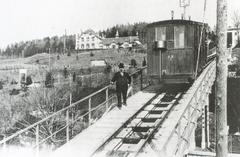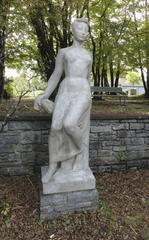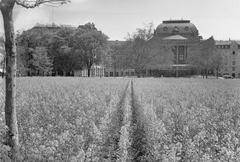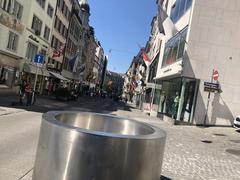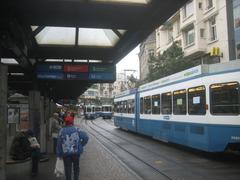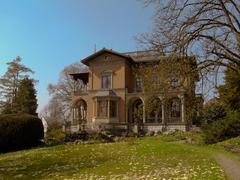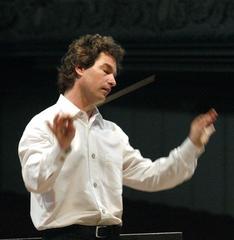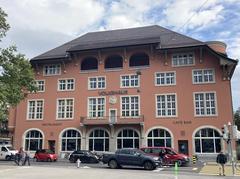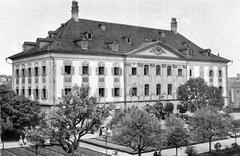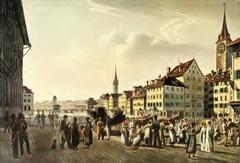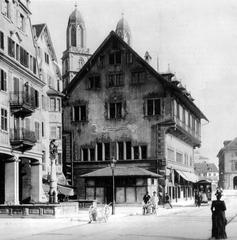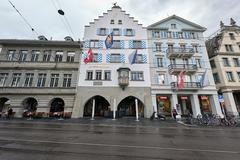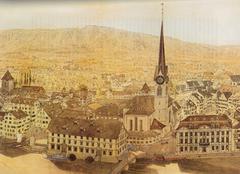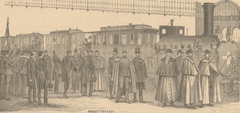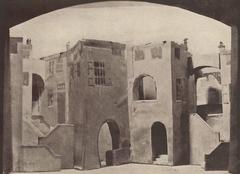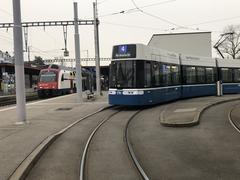
Paradeplatz Zürich Visitor Guide: Hours, Tickets, and Tips
Date: 24/07/2024
Introduction
Paradeplatz, located in the vibrant heart of Zürich, Switzerland, is a quintessential example of a place where history seamlessly intertwines with modernity. Known for its significant financial influence and rich cultural heritage, Paradeplatz tells the story of Zürich’s transformation from a simple livestock market to a global financial powerhouse. Originally known as Säumärt or ‘pig market’ in the 17th century, the square has undergone several transformations, reflecting the dynamic shifts in the city’s socio-economic landscape (Tripoto). Today, Paradeplatz is more than just a financial hub; it is a symbol of Zürich’s architectural grandeur and cultural vibrancy. This guide offers a detailed exploration of Paradeplatz, covering its historical evolution, architectural significance, practical visitor information, and much more. Whether you are a history enthusiast, a financial expert, or simply a curious traveler, Paradeplatz offers a unique blend of attractions that cater to all interests.
Table of Contents
- Introduction
- Early Beginnings
- Transformation in the 19th Century
- Emergence as a Financial Center
- 20th Century Developments
- World War II and Beyond
- Modern-Day Paradeplatz
- Architectural and Cultural Significance
- Paradeplatz in Popular Culture
- Accessibility and Transportation
- Paradeplatz as a Shopping Destination
- Culinary Delights - Confiserie Sprüngli
- Historical Events and Clashes
- Visitor Tips
- Practical Visitor Information
- Special Events and Guided Tours
- FAQ
- Conclusion
Early Beginnings
Paradeplatz, located in the heart of Zürich, Switzerland, has a rich history that dates back to the early 17th century. Originally, the area was known as Säumärt, which translates to ‘pig market’ in German, reflecting its initial use as a livestock market. This name was indicative of the square’s primary function during that period, serving as a bustling center for trading livestock, particularly pigs (Tripoto).
Transformation in the 19th Century
The transformation of Paradeplatz into a significant urban space began in the 19th century. In 1819, the square was renamed Neumarkt, meaning ‘new market,’ as part of an effort to modernize and rebrand the area (Wikipedia). However, the most pivotal change occurred in 1865 with the construction of Bahnhofstrasse, one of Zürich’s main thoroughfares. This development marked the beginning of Paradeplatz’s evolution into a financial hub.
Emergence as a Financial Center
The establishment of Credit Suisse, originally known as Schweizerische Kreditanstalt, on Paradeplatz in 1865 was a turning point in the square’s history. This event signaled the start of Paradeplatz’s transformation into a major banking center. Over the years, other financial institutions, including UBS, also established their headquarters in the area, further cementing Paradeplatz’s reputation as a financial powerhouse (Explorial).
20th Century Developments
The 20th century saw Paradeplatz solidify its status as a key financial district. The square became synonymous with wealth and the Swiss banking industry. The presence of major banks like UBS and Credit Suisse, along with other financial institutions such as Julius Bär, Vontobel, and Zürcher Kantonalbank, contributed to Paradeplatz’s reputation as one of the most expensive pieces of real estate in Switzerland (Tripoto).
World War II and Beyond
During World War II, Paradeplatz played a significant role in the global financial landscape. The Swiss Bank Corporation, now part of UBS, was involved in gold transactions with both Allied and Axis powers. These activities have left an indelible mark on the history of Paradeplatz, highlighting its importance not just as an economic center but also as a site of historical significance (Explorial).
Modern-Day Paradeplatz
Today, Paradeplatz remains a symbol of Zürich’s financial prowess. The square is dominated by the grand headquarters of Credit Suisse Group AG and UBS AG, which continue to be major players in the global banking industry. The area is also home to several private banks and asset management firms, further enhancing its reputation as Zürich’s Wall Street (Explorial).
Architectural and Cultural Significance
Paradeplatz is not only significant for its financial institutions but also for its architectural and cultural heritage. The square features a blend of neoclassical and modern architectural elements, reflecting its historical evolution and contemporary relevance. Notable buildings around Paradeplatz include the palatial 1876 headquarters of the Schweizerischen Kreditanstalt and the Hotel Savoy Baur en Ville, built in 1838 and reconstructed in 1978 (Planetware).
Paradeplatz in Popular Culture
Paradeplatz has also found its place in popular culture and public consciousness. It is often featured in discussions about wealth, finance, and the Swiss banking industry. The square’s prominence is further highlighted by its frequent appearance in media and literature that explore themes of economic power and financial history.
Accessibility and Transportation
Paradeplatz is one of the main nodal points of the Zürich tram network, making it easily accessible from various parts of the city. The tram stop at Paradeplatz is served by multiple lines, including lines 2, 6, 7, 8, 9, 11, 13, and 17, ensuring that visitors can conveniently reach this iconic square (Wikipedia).
Paradeplatz as a Shopping Destination
In addition to its financial significance, Paradeplatz is also a premier shopping destination. The square is located at the heart of Bahnhofstrasse, one of the world’s most exclusive shopping streets. Visitors can explore a wide range of luxury boutiques, high-end stores, and gourmet shops, making Paradeplatz a must-visit location for shopping enthusiasts (Tripoto).
Culinary Delights - Confiserie Sprüngli
One of the highlights of Paradeplatz is Confiserie Sprüngli, a renowned confectioner’s café that has been a favorite stop for locals and tourists since it opened in 1856. The café is famous for its Luxemburgerli macarons, truffles, bonbons, and cakes. The retail shop on the street floor and the upstairs café-salon offer a delightful experience for those looking to indulge in gourmet treats (Planetware).
Historical Events and Clashes
Paradeplatz has also been a site of historical events and political clashes. Notably, it was the scene of clashes between insurgents and cantonal troops during the 1839 Züriputsch, a political uprising that played a significant role in the establishment of the modern canton of Zurich (Wikipedia).
Visitor Tips
For visitors looking to explore Paradeplatz, here are several tips to enhance the experience:
- Walking Tours: Joining a free walking tour of Zürich is an excellent way to learn about the history and significance of Paradeplatz. These tours often start at Paradeplatz and cover various historical and cultural landmarks in the city (Travel Inti).
- Shopping and Dining: Take time to explore the luxury shops along Bahnhofstrasse and enjoy a meal or dessert at Confiserie Sprüngli.
- Tram Accessibility: Utilize the extensive tram network to reach Paradeplatz conveniently from different parts of Zürich.
Practical Visitor Information
- Visiting Hours: Paradeplatz itself is an open public space and can be visited at any time. However, the operating hours for shops, banks, and cafes around the square vary. Generally, shops and banks are open from 9 AM to 6 PM on weekdays, with shorter hours on Saturdays and closed on Sundays.
- Tickets: No tickets are required to visit Paradeplatz itself. However, guided tours or special events may have associated costs. It is recommended to check with local tour operators for the latest information.
Special Events and Guided Tours
Paradeplatz occasionally hosts special events and guided tours that offer deeper insights into its historical and financial significance. Visitors can participate in themed tours that focus on the banking industry’s history, architectural highlights, or cultural aspects of the area.
FAQ
-
What is Paradeplatz known for? Paradeplatz is known for being Zürich’s financial hub, housing major banks like Credit Suisse and UBS. It is also a prominent shopping destination and cultural landmark.
-
How can I get to Paradeplatz? Paradeplatz is easily accessible via Zürich’s extensive tram network, with multiple lines serving the Paradeplatz tram stop.
-
Are there any famous cafes in Paradeplatz? Yes, Confiserie Sprüngli is a renowned café located at Paradeplatz, famous for its Luxemburgerli macarons and other gourmet treats.
Conclusion
Paradeplatz stands as a testament to Zürich’s financial and cultural evolution, offering visitors a unique blend of historical significance and modern-day allure. Whether you’re interested in exploring its rich history, indulging in luxury shopping, or savoring gourmet delights, Paradeplatz has something to offer for everyone. Be sure to make it a part of your Zürich itinerary and experience its multifaceted charm. For more updates and information on Zürich’s attractions, download our mobile app Audiala, and follow us on social media.
References
- Wikipedia contributors. (2023, July 24). Paradeplatz. In Wikipedia, The Free Encyclopedia. Retrieved from https://en.wikipedia.org/wiki/Paradeplatz
- Tripoto. (n.d.). Paradeplatz. Retrieved from https://www.tripoto.com/zurich/places-to-visit/paradeplatz
- Explorial. (n.d.). Zurich Paradeplatz. Retrieved from https://explorial.com/sights/zurich-paradeplatz/
- Planetware. (n.d.). Zurich Tourist Attractions. Retrieved from https://www.planetware.com/tourist-attractions-/zurich-zurich-ch-zh-zr.htm
- Travel Inti. (n.d.). Paradeplatz. Retrieved from https://travelinti.com/paradeplatz/

